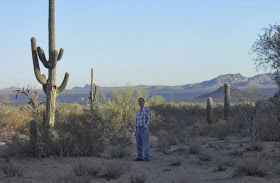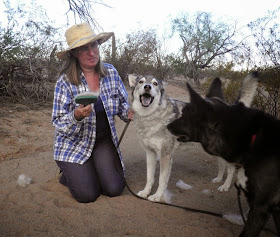I think I have found my new little paradise. On the last weekend in September I was invited to take part in a biological survey of Rancho las Avispas and Rancho Esmeralda in northern Sonora, Mexico. This was a project of MABA (Madrean Archipelago Biological Alliance). MABA is an organization concerned with protection of biodiversity and habitats on both sides of the political border between the US and Mexico. The result of our weekend trip made it very obvious how arbitrarily this border cuts through naturally cohesive areas. I counted hundreds of insect species, but none of them couldn't be found north of the border as well.
 |
| Just out of the cars and already searching for bugs and plants at Rancho las Avispas |
This didn't make the excursion less interesting and beautiful. The two ranchos included three canyons with clear running water and beautiful rock formations, oak and ash trees, huge sycamores and lush under-growth. Tom Van Devender and Ana Lilia Reina kept a running count of plant species, they knew the area well, so they were only adding to what they had seen and collected before. They still brought back a very fat herbar strapped the roof of their car.
 |
| Tom Van Devender and Ana Lilia Reina, leaders of the trip and great botanists |
The monsoon rain had been generous, but there were not as many blooming perennials as we had hoped for. So there were few
hymenoptera species for Justin Schmidt, but enough Polistes wasps to understand the name of Rancho las Avispas. The air was positively abuzz with those guys and they even showed up at the lights at night.
 |
| Polistes major castaneicolor |
Our dragonfly and butterfly experts seemed happy though, and I forgot how
many grasshoppers Bob Behrstock counted because he kept adding species continuously. Over the last years we made two exciting orthopteran discoveries in Arizona: Machaerocera mexicana (Mexican Blue-wing Grasshopper) and Aztecacris gloriosus (Atascosa Gem Grasshopper).
 |
| Machaerocera mexicana (Mexican Blue-wing Grasshopper) and Aztecacris gloriosus (Atascosa Gem Grasshopper) |
The latter had been believed to be endemic to the mountains around Sycamore Canyon and Ruby Road. But at Rancho las Avispas we found the species in abundance. The Mexican Blue-winged GH preferred shady creek sides at Rancho Esmeralda, very similar to the habitat at Las Cienegas in Arizona.
 |
| Archilestris magnificus and Systropus arizonicus. |
Robber flies and other
Diptera were numerous and impressive. I found a mating pair of the largest one,
Archilestris magnificus, and a bombyliid mimicked an Amophila wasp so closely that it had us all fooled at first. It was so active that I could only photograph it after it had been caught.:
Systropus arizonicus.
I found and photographed nearly
80 species of beetles and I could identify most of them with the help of my flickr collection of Arizona Beetles.
 |
| Calligrapha multiguttata and Pachybrachis bivittatus |
I was most excited about a rare Calligrapha and a little Pachybrachis that I hadn't seen before, but it turned out that Mike Quinn had found that species in Sycamore Canyon, Arizona, during our BugGuide gathering. That location is probably only 20 miles from Rancho Esmeralda as the crow flies.
Close to
30 species of Hemiptera were found in the field and at the black light at night. The greatest surprise was the tiny Systelloderes in the family
Enicocephalidae (Unique-headed Bugs). Rarely have I heard a more descriptive name.
Because John Palting couldn't make this trip, I also did my best
documenting the moths at my mercury vapor light. Many species were old acquaintances from Arizona.
 |
| Ectypia clio (Clio Tiger Moth - Hodges#8249) |
I was happy to finally get a good photograph of the beautiful Clio Tigermoth for my
Tiger and Lichen Moth pages.
To be safe, I posted the moths to BugGuide where Maury Heiman, Dave Ferguson and Randy Hardy helped with the identifications. Now I have to find out whether I can leave my posts there - Mexico is not within BugGuide territory but most biologists think that at least Sonora should be included....
 |
| Chip Hedgecock at Rancho Esmeralda |
The three canyons reminded me very much of Sycamore Canyon and Brown Canyon in the Baboquivaries of Arizona, but somehow these Sonoran Canyons seemed more accessible and yet at the same time more secluded and untouched. One reason for the feeling of remoteness was certainly that driving in, we met only some vaqueros on horseback and no Border Patrol vehicles or groups of smugglers. At the border in Arizona there is usually a lot of traffic of one or the other.
 |
| Cañada Adrián |
So somehow it felt much friendlier and safer than in the canyons just north of the border. But it also meant that the steep gravel road wasn't improved for Border Patrol use, and after our first hike at las Avispas I found my van sadly tilted and one tire completely flat.
 |
| Eric Wallace, I, and John Ochoa checking out insect larvae on a bottle that we found submersed in the Arizona Creek |
That was quite a shock because I did not like at all the idea of driving back over the steep pass on my doughnut spare tire. But John Ochoa, our extremely generous host, only smiled and said they would find me a 15 in tire from one of their vehicles or just plug my tire...half an hour later the ranch foreman was back with my wheel, put it back on, and said he would watch for the next day if it held the pressure - it did. If I ever have car trouble again I hope it happens at a self sufficient Rancho with warm and helpful people like that! They cooked spicy food just as I like it and they had great loving dogs!

If you would like to see my photo documentation of the observed insects, please click on the highlighted links in the text. They will open groups of images that are organized in flickr sets. As they become available I will also add links to the MABA data base for the Ranchos las Avispas and Esmeralda. Nowadays I'm an arthropod person, so I'll leave birds and herps to Bob, Steve Minter and Eric Wallace...
Thank you so much to Tom Van Devender and Ana Lilia Reina who organized the trip, John Ochoa, our gracious host, John Palting who connected me to the MABA group, and the other dedicated, knowledgeable naturalists and biologists who made me immediately feel like a part of the group.





































